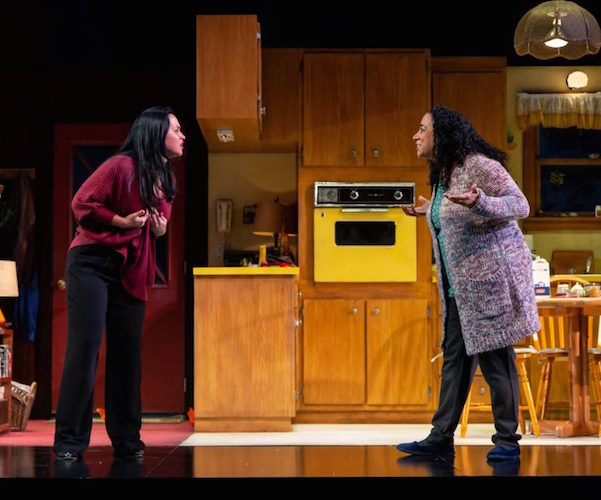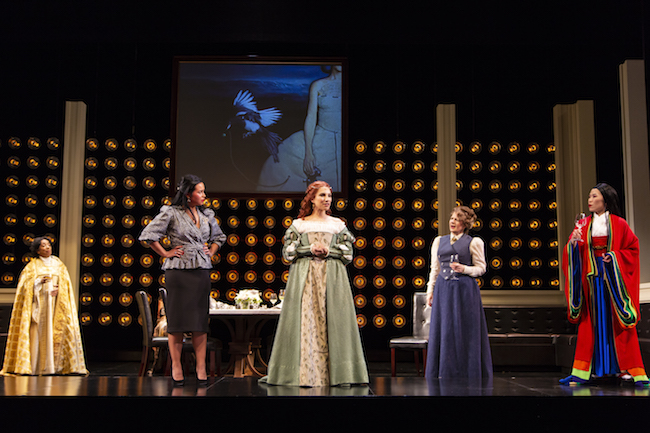Theater Review: “Top Girls” — As Brilliant and Harsh As Ever
Top Girls’ conflicts and political themes seem more relevant than ever in this excellent production.
Top Girls by Caryl Churchill. Directed by Liesl Tommy. Staged by the Huntington Theatre Company at the Huntington Avenue, Boston, MA through May 20.

Carmen Zilles and Sophia Ramos as sisters Marlene and Joyce in the Huntington Theatre Company production of “Top Girls.” Photo: T Charles Erickson.
By Helen Epstein
Caryl Churchill’s brilliant, harsh, politically relevant, and artistically challenging play opened at the Royal Court Theatre in London in 1982 and, 35 years later, it remains harsh, relevant, brilliant, and challenging. I first saw it when Joe Papp brought the Royal Court production to New York’s Public Theater that year: Margaret Thatcher was Prime Minister of the UK, Ronald Reagan was POTUS, and Judy Chicago’s art installation “The Dinner Party” had, two years earlier, featured an enormous table with 39 place settings for historical and mythic women, including Susan B. Anthony, Virgina Woolf, Georgie O’Keefe, Eleanor of Aquitaine, and Sojourner Truth.
In Top Girls, Churchill dramatizes a Saturday night dinner party hosted by London Top Girl Marlene, a celebration of her recent promotion at a 20th century employment agency. Marlene invites five historical and mythic figures: 19th century British explorer Isabella Bird, who traveled around the globe alone; 13th century Japanese courtesan, memoirist, and, later, Buddhist nun Lady Nijo; 16th century peasant Dulle Griet, whose portrait is attributed to Bruegel the Elder; and Italian 9th century Pope Joan who, like yeshiva girl Yentl, disguised herself as a boy in order to study. Rounding out the dinner sextet is 14th century Griselda, the patient, self-sacrificing girl married to a marquis who separated her from her children — immortalized by Boccaccio, Petrarch and Chaucer. There are 17 women characters in all and no men. The roles are performed by a cast of seven.
The characters’ backstories are as arcane and allusive as references in a Tom Stoppard play and it’s obvious that Churchill, rather than Marlene, drew up the guest list. All (except for sly, armor and helmet-clad Griet) are loquacious and self-absorbed. All speak in strong, nationally-appropriate accents. And, because Churchill likes to play with overlapping dialogue (the device of characters talking over one another that film-maker Robert Altman pioneered), quite a few of the ladies’ lines are lost during the very long first act.
Usually I find overlapping dialogue annoying but, in this superb production of Top Girls, it serves to underscore the intensity of each woman’s need to be heard as well as augmenting the rising anger of the group. Director Liesl Tommy understands the play so well, and directs it with so sure a hand, that the multiple, concurrent streams of consciousness and their echoes sound like verbal chamber music. The women move around the dinner table drinking wine, telling their stories, making pronouncements, and discussing clothes, class, theology, love, marriage, illness, children. Male power, the birth and loss of children and money are recurrent themes. We strain to catch the gist of the conversation, trying to follow the story lines, understand how one monologue reflects or deflects another, how the torrents of words accumulate into themes, what silences the speakers. For some people, this is an exciting theatrical experience; for others – especially those who privilege text over spectacle — a frustrating one. I am usually in the second camp, but found myself enjoying the cacophony and becoming increasingly intrigued by Tommy’s design choices.
The party takes place on a confusing, disorienting set in which a large dinner table is only one of several design elements. These include a back wall filled with game show marquee lights that flash on and off or are dimmed depending on the mood; wood-and-leather furnishings that suggest an expensive gentlemen’s club; a contemporary flat screen TV with an enigmatic “portrait of a lady” that includes a dog, a bird on a string and, as the scene evolves, a banjo and revolver. As Marlene’s dinner guests make their entrances, the marquee lights flash and the waiter/photographer snaps their close-ups. The characters are dressed in unforgettable, extravagantly apt costumes by Linda Cho.
I would be hard-pressed to choose a favorite among those wonderful costumes or the characters who wear them, their extraordinary sagas, or the actors who portray them. Churchill wrote Top Girls for an all-white British cast; the Huntington production is multi-racial and outrageously versatile. Some of the performers are making their first appearance on the Huntington’s stage. Each but Carmen Zilles, who plays Marlene, doubles in two or three roles. There are no roles for men.

Sophia Ramos, Carmen Zilles, Elia Monte-Brown, Paula Plum, and Vanessa Kai in the Huntington Theatre Company production of “Top Girls.” Photo: T. Charles Erickson.
Zilles plays the character that will be the most familiar to a contemporary audience, whether hosting her sophisticated London dinner party, dominating her office, or returning to her childhood home in the English countryside, where her older sister and daughter still live. Smart, practical, ambitious, and simmering with anger, Zilles makes Marlene’s psychological shuttle between urban career woman and resentful younger sister and back emotionally credible. The polarities dramatize the deep conflict between those who are determined and/or able to leave domesticity and those who are left behind.
Veteran Boston actor Paula Plum is characteristically adept as another relatively familiar type: the intrepid Scottish explorer and writer Isabella Bird (born 1831) who traveled around the world alone, yet seems overshadowed in this exotic company of more colorful ladies, such as the flamboyant Japanese courtesan Lady Nijo.
As played by Vanessa Kai, Lady Nijo (“The first half of my life was all sin; and the second all repentence”) conveys an interesting blend of fragility, fierceness, and an unexpected sense of humor. Sophia Ramos is a serene, sometimes smug, dead-pan Pope Joan, who goes into labor while she is astride a horse. She describes the experience of giving birth (“I thought it was something I had eaten”) and is stoned to death immediately upon delivering the child. Ella Monte-Brown, who looks like she stepped out of the pages of illuminated manuscript, portrays the mild, patient Griselda (“I’d rather obey the Marquis than a boy from the village”), who forgives her husband’ brutality.
For me, the actor who steals her scenes is the mostly silent, sword-polishing, food-grubbing Carmen M. Herlihy as Breughel’s Griet. When the other guests finally take notice of her and ask her how many children she has, Griet grunts, “Ten!” After Griselda tells her painful story of loss and obedience, Griet climbs onto the dinner table and brings the party to an end with her rousing account of leading a band of armored peasant women to fight male devils in the mouth of hell.
The Huntington Theatre Company apparently chose to revive 'Top Girls' after last year’s presidential election, which many have argued revives the political polarization of the 1980s.Click To TweetThe second act could not be farther removed from the fantasy and urban privilege of Marlene’s dinner party. Set in spaces apt for a television sit-com, these scenes are grimly realistic. Two girls – Angie, Marlene’s 15-year-old niece (extraordinarily played by Carmen M. Herlihy) and Kit (played by Kiara Pichardo), a neighbor’s child – are engaged in the bickering and bullying of kids with nowhere to go and nothing to do. In an extended flashback, Churchill explores the harshness of the working-class rural England that Marlene left when she was just a bit older than Angie. Her older sister Joyce (played by Sophia Ramos) has remained to care for the sisters’ parents and what turns out to be Marlene’s daughter – “in the remedial class for the last two years” and “one of those girls who might never leave home.” Marlene’s sister holds down four different cleaning jobs to support the two of them and the sisters’ aged mother. Their father drank away their money. Joyce’s abusive husband abandoned her.
With the contrast between these two sisters, two acts and two worlds, the playwright examines what has stayed the same and what has changed over the centuries for women. There is little glamor here — not in the dialogue, nor costumes, nor sets. The overlapping dialogue of Act One gives way to raw, ugly, and clearly intelligible lines of argument about the choices contemporary women do or don’t have: the terms of their employment; the terms of their relations with the fathers, lovers, and husbands; their obligations to or abandonment of their children; their definitions of success.
The Huntington apparently chose to revive Top Girls after last year’s presidential election, which many have argued revives the political polarization of the 1980s. Since its premiere the script has become a classic of contemporary British theater; it is one of the most produced of Churchill’s 45-odd plays and has had both a Broadway and a West End revival. Except for one scene, in which a male executive’s wife comes to Marlene’s office to plead her husband’s case and calls Marlene a “ballbuster,” Top Girls is far from dated. Rather, its conflicts and political themes seem more relevant than ever in this excellent production.
The credit for the staging goes to director Tommy. Her deep understanding of this many layered play is evident in every aspect of the evening (as a student, she performed the role of Pope Joan at Trinity Rep). From the unconventional yet spot-on casting to the highly effective original music and sound design by Broken Chord, Daniel Baker, and Aaron Meicht, her vision is clear, strong, and thought through. Top Girls is not always comfortable or easy to understand, but it’s the real thing.
Helen Epstein is the author of Joe Papp: An American Life and other books about the arts. She has been reviewing books and theater for artsfuse since 2010. Her own ten books of non-fiction can be found at Plunkett Lake Press.
Tagged: Caryl Churchill, Culture Vulture, Huntington-Theatre-Company, Liesl Tommy

[…] As Helen Epstein puts it, “The dialogue of Act One (with historic figures) gives way to raw, ugly, and intelligible lines of argument about the choices contemporary women do or don’t have: the terms of their employment; the terms of their relations with the fathers, lovers, and husbands; their obligations to or abandonment of their children; their definitions of success.” […]